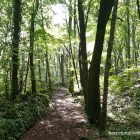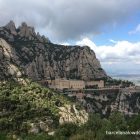The Croscat Volcano is the highest volcano in mainland Spain and is one of forty volcanoes located in the Garrotxa Volcanic Zone, 100 km northwest of Barcelona.
At this point, I have to point out that you shouldn’t come here expecting to see the likes of Krakatoa, Mount Fuji, Cotopaxi or other impressive volcanoes which you may have seen in Asia or South America. The volcanoes in the Garrotxa region last erupted more than eleven thousand years ago and mostly look like small tree-covered hills.
The Croscat volcano is the youngest volcano in the area and is approximately eleven thousand years old. The volcano was formed by two eruptions and, instead of having a circular crater, is crescent-shaped when viewed from the air.

During the nineteen sixties and seventies, the Croscat volcano was mined for clay. The clay pits were finally closed in 1991, leaving a large section of the volcano exposed, similar to the cross-sections of volcanoes that you may have seen in school textbooks or on the internet.
The clay pits (called “grederes” in Catalan) have been restored, and the area is now protected to prevent further erosion. The volcano can be visited free of charge, and a small information centre near the entrance to the clay pits has a display explaining how the volcano formed.
Visiting the Croscat Volcano
The Croscat volcano is open to the public and can be visited free of charge. You leave your car at the Santa Margerida car park and follow walking route number fifteen (see map below). The route takes about an hour to complete, is well signposted and suitable for walkers of all ages.

The first section of the route runs parallel with Route 1, which is a four-hour circular route that links the Santa Margarida volcano, the Jordà beech forest and the Croscat volcano.
As you leave the car park, there’s a pelican crossing that crossed the GI-524 road from Olot to Santa Pau. You then follow the footpath alongside the road for a few metres before turning right towards Restaurant Santa Margerida.
From here, you follow an asphalted lane for about five minutes until you pass a second small restaurant called Restaurant Masnou. You leave the asphalted road shortly after this and follow a dirt track between fields directly towards the volcano (see photo above).
The track continues uphill and, shortly after entering the woods, you come to a bifurcation. To get to the clay pits, you take the right-hand trail, which follows the contours of the volcano through the trees.

A few minutes later, the footpath leaves the shade of the trees and descends, between two wooden handrails, towards a small visitor centre near the clay pits entrance. From here, the path follows a circular route around the lunar landscape of the interior of the volcano.
After visiting the volcano, you retrace your footsteps back to the car park.
The route is approximately three kilometres long and is well signposted. You simply follow the signs marked Grederes del Volcà Croscat.

How to get to the Croscat Volcano and where to Park
By Car
Although it is possible to visit the Croscat Volcano by public transport, it’s far more convenient to go by car.
It takes approximately an hour and a half to drive from Barcelona to the Croscat Volcano. Take the C-17 from Barcelona to Vic, followed by the C-37 to Olot. If you’re using Google Maps, look for “Aparcament de Santa Margerida”.
If you have time, I recommend that you combine your visit to the volcano with a walk in the Fageda d’en Jordà beech forest and then return to Barcelona along the GI-524, stopping at the medieval village of Santa Pau and the lake at Banyoles before returning to Barcelona via the AP7.

By Bus
Bus company TEISA operate four buses per day from Barcelona to Olot.
From here, there are four buses daily to Santa Pau, which stop at the Santa Margerida car park. If you decide to visit by bus, I recommend that you contact the bus company in advance to make sure that the buses are running.
For information about where to stay and other things to do in the area, check out my post about the Fageda d’en Jordà beech forest.




